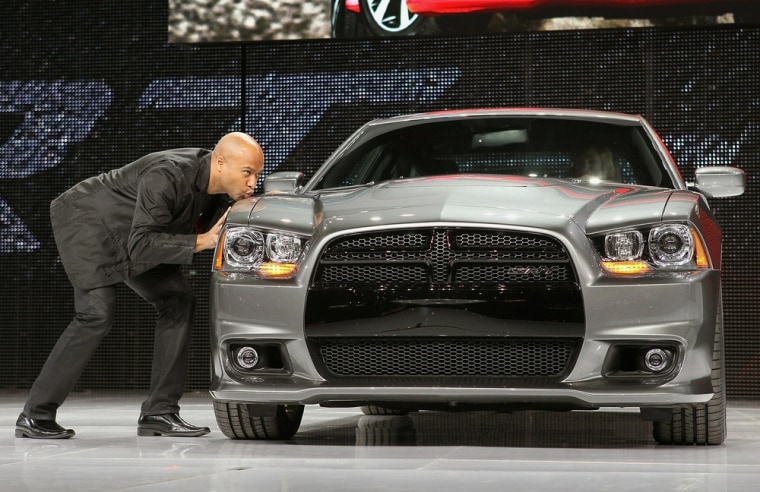This is the year of the electric car, or so one might believe based on the headlines of recent months, with new vehicles like the Chevrolet Volt plug-in hybrid and Nissan’s electric Leaf racking up awards and rolling into car showrooms.
So, what should we make of this month’s Chicago auto show, where potential customers will find the spotlight shining not only on the latest lithium-ion-powered wonders, but also on some of the most powerful cars ever to roll off an assembly line?
At the Chevy stand, for example, the Volt made way for the new Camaro ZL1 — a 550-horsepower version of the reborn “pony car,” which General Motors’ design chief Ed Welburn proclaimed “the most technically advanced Camaro ever built.”
A quick walk across the vast McCormick Place convention center found Ralph Gilles, the Dodge brand’s general manager, kneeling to plant a kiss on the fender of the new, 465-horsepower Dodge Charger SRT8. Gilles — who also serves as Chrysler’s corporate design chief — is one of the first in line for the high-performance sedan, which traces its roots back to the pre-oil shock era of anything-goes muscle cars.
“Performance is back,” Mark Reuss, GM’s president of North American operations, has said on numerous occasions.
For all the attention GM has given the electric Volt, the automaker has delivered significantly more muscle car models to market over the last year, including an assortment of Camaros, and several new versions of the Cadillac V-Series, including the 550-hp CTS-V Coupe.
Indeed, the Chevy Camaro (with an EPA fuel economy rating of 19 MPG in the city and 30 MPG on the highway) was one of the hottest cars of 2010, notably knocking down the king of the pony-car hill, the Ford Mustang, for the first time in 25 years.
Ford used the Detroit auto show, last month, to reveal several new battery-based vehicles, including an electric version of its new Focus, and the C-Max Energi, a plug-in hybrid version of its new microvan. But the automaker is also burning rubber with the new Mustang GT500, which pumps out an impressive 500 hp.
Even Toyota, which used the Detroit show to reveal a new family of Prius-badged hybrids, is getting into the action. Its Lexus luxury division recently started deliveries of the LF-A supercar, and the Japanese automaker is getting ready to reveal, at next month’s Geneva Motor Show, a new high-performance sports car developed in partnership with the smaller Japanese carmaker Subaru.
High-performance models like the Camaro, the Mustang, the Charger and the Challenger (another Dodge muscle car) collectively outsell hybrid-electric vehicles like the Toyota Prius and Ford Fusion Hybrid — the darlings of the environmental set.
But there’s a caveat to that success. The highest horsepower offerings, such as the Camaro ZL1 and Charger SRT8, make up a relatively modest niche, as most car buyers opt for more mundane versions of these cars, such as the V6-powered Mustang.
Once derided as a “secretary’s car,” the Mustang’s base model has only minimal muscle, yet it still delivers surprising performance — a hefty 305 hp (about 50 percent more than the top-line Mustang GT of two decades ago). But the V6-powered Mustang also gets an EPA fuel economy rating of 30 miles per gallon on the highway, which underscores some of the big changes that have occurred since the days when muscle cars ruled the road.
New technologies, like turbocharging and direct injection, make it possible for cars to churn out significant amounts of power when needed, but still maintain acceptable fuel economy. The new Charger SRT8, for example, can idle half of its cylinders when the demand for power is low, significantly reducing fuel consumption.
And that’s only the beginning. Mercedes-Benz is readying a pure battery-electric version of its gull-winged SLS supercar, which will debut in 2013. And little Tesla, the Silicon Valley start-up, has already sold more than 1,000 of its two-seat Roadster sports cars.
British specialty carmaker Lotus is developing an assortment of new models that will use a special hybrid driveline — initially developed for the Formula One race circuit — to punch out some extra performance while allowing the carmaker to utilize a smaller, more fuel-efficient engine.
Porsche is taking a similar approach with its 918 sports car, a race version of which was introduced at the 2011 Detroit auto show.
And while company officials won’t comment, there have been numerous reports that Ford will be bringing back the legendary GT nameplate. But the new version will supposedly use supercharging and hybrid power to help it deliver 0 to 60 acceleration in barely 3 seconds.
While it’s hard to find a manufacturer these days that isn’t working on a battery car, plug-in or conventional hybrid, the same can be said for performance and muscle cars.
Even Hyundai, a brand traditionally known for its low-price and high mileage, is getting in on the act. During its Chicago auto show preview this year the automaker said it would add another 51 hp to its popular Genesis sedan, bumping the numbers up to 429 hp.
And with federal mileage standards set to make some big jumps in the years ahead, automakers are under pressure to squeeze more miles out of every gallon of gas — yet the market also wants them to deliver more muscle, as this year’s Chicago auto show underscores. The good news is that the latest drivetrain technology is allowing the industry to do both.
